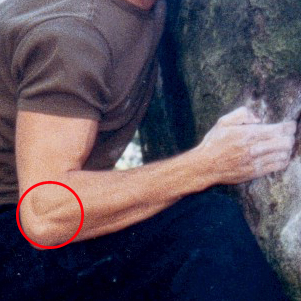|
Epicondylalgia
Definition
The epicondyle refers to the lateral area of the elbow, at the insertion of the fingers and wrist extensor tendons (fig 1).

Fig 1: Localisation of the epicondyle
Epicondylalgia refers to all pain in this area. This term is now preferred to the one of epicondilitis, just as tendinopathy is used rather than tendinitis. Moreover, if some epicondylian pain is due to the local pathology of the extensor tendons, others can originate from the joints (humerus-radius/radius-ulna joints), the cervices (cervical joint dysfunction which causes a projected pain) or the nerves (strangulation of the nerve where it passes through the elbow).
In the case of a lateral elbow tendinopathy (commonly referred to as “tennis elbow”), pain is felt at palpation, stretching and forced contraction.
With a local joint dysfunction, pain is felt at the palpation of the joint space.
When the epicondylalgia originates from the cervices, pain is felt at palpation but not at forced contraction.
With a radial nerve injury, the usually nocturnal pain is accompanied by sensitive signs of the dorsal side of the forearm.
Mechanism of the lesion
In cases of a tendinopathy:
Putting the tendons under excessive strain (of volume and intensity), accumulative strain without complete recovery, persisting contractures between the sessions contribute to their degeneration, in particular because of poor revascularization of the area.
Pinch grips put enormous strain on the extensor muscles of the wrist.
In cases of joint dysfunctions of the elbow:
The inertia of a dyno landing, the brutal and uncontrolled coming down during traction work may overwork the elbow joint and contribute to small joint “movings”.
In cases of joint dysfunctions of the cervical:
The persistence of contractures at the scapular belt and the neck favours compensatory posture which may disturb the correct mobility of the cervical joint surfaces. Climbing uses a great number of muscles that cling to the scapular belt and the cervical rachis. Cervicalgias are common and are favouring factors.
Once again, it is important to remember that the repetition of a movement is harmful for the structures
Prevention
Technique correction:
Do not stretch the elbow completely during muscle training and make sure that during tractions you always control the descent.
Do not charge too much weight.
Correction of the exercise schedule:
Do not charge too much weight or volume.
Schedule regular rests.
The quality of the training is more important than the quantity.
Correction of the physical preparation:
Strict warm up.
Gradual increase of training loads.
Systematic stretching of the extensor and flexor muscles of the fingers and the wrist after each training session.
And systematic stretching of all upper limb muscles, the scapular belt and the neck (see stretching exercises).
Treatment
Ice cube massage 3 times per day till the pain disappears.
Application of an anti-inflammatory gel after the ice treatment for 7 days maximum (respect the manufacturer’s directions).
If the symptoms persist more than one week consult a sports doctor and ask for a prescription for reeducation sessions.
Early care by professionals can prevent the condition from becoming chronic.
In cases of joint dysfunctions of the elbow or cervical, osteopathy sessions should be scheduled as soon as possible.
Strapping: the application of a non-elastic support bandage (like Strappal or Omnitape) may in some cases give relief to the area when taking up training again.
Before you apply the strapping, shave the area: the bandage will stick better and you won’t make a funny face when taking it off!
Wrap the bandage around the forearm twice by passing precisely at the point of pain and tighten it slightly (the bandage should be tightened a little, but not to the extend that the circulation is cut off or movement inhibited. It should give you proper support).
|

